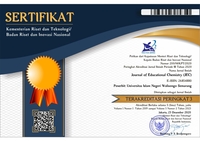Geometrichem Game to Improve Students' Learning Autonomy in Molecular Shape Topic
DOI:
https://doi.org/10.21580/jec.2021.3.1.7714Keywords:
geometrichem, learning autonomy, molecular shapeAbstract
Learning media can help teachers to convey material to students. One of the learning media that can be used is the game. The aim of this research is to determine the feasibility of Geometrichem game as a learning medium to improve student learning autonomy in molecular shape topic according to validity, practicality, and effectiveness. Geometrichem game is expected to improve student learning autonomy. The research method applied was Research and Development: (1) preliminary study, (2) development of the product, (3) trial. The trial was conducted to 18 students of SMAN 1 Gresik. The result showed that Goemterichem game is feasible as a learning medium in molecular shape topic as (1) validity reached 89,29% or very valid, (2) practicality reached 84,03% or very practical according to response questionnaire, and 78,79% or good according to student activity observation, (3) effectiveness reached 77,78% according to classical completeness. Geometrichem game improved student learning autonomy in student motivation, the use of learning resources, self-evaluation, and environmental factor aspects, but not in learning strategy, planning, and self-monitoring aspects.Downloads
References
Aeni, N. (2019). Pengembangan Modul Bermuatan Pendidikan Karakter Materi Elektrokimia Program Keahlian Teknik Instalasi Tenaga Listrik. Journal of Educational Chemistry, 1(2), 69–81.
Ahmad, S., Hussain Ch, A., Batool, A., Sittar, K., & Malik, M. (2016). Play and Cognitive Development : Formal Operational Perspective of Piaget' s Theory. Journal of Education and Practice, 7(28), 72–79.
Alomari, I., Al-samarraie, H., & Yousef, R. (2019). The Role of Gamification Techniques in Promoting Student Learning: A Review and Synthesis. Journal of Information Technology Education: Research, 18, 395–417.
Andrade, H. L. (2019). A Critical Review of Research on Student Self-Assessment. Front. Educ., 4(87), 1–13.
Firat, M. (2016). Measuring the e-Learning Autonomy of Distance Education Students. Open Praxis, 8(3), 191–201.
Huang, Y. (2019). Exploring Students' Acceptance of Educational Computer Games from The Perspective of Learning Strategy. Australasian Journal of Educational Technology, 35(3), 132–149.
Islami, V. D. (2018). Peningkatan Kemandirian dan Prestasi Belajar Pemrograman Dasar Siswa Kelas XI TKJ Melalui Pemanfaatan Modul di SMK Negeri 1 Bantul. Undergraduate Thesis. Universitas Negeri Yogyakarta.
Jácome, É. P. (2012). Promoting Learner Autonomy Through Teacher-Student Partnership Assessment in an American High School : A Cycle of Action Research. PROFILE, 14(2), 145–162.
Khulliyah, & Fadhlan, A. (2019). Penguasaan Konsep dan Retensi Melalui Pogil ( Process Oriented Guided Inquiry Learning ) Bermuatan Multiple Level Representation. Journal of Educational Chemistry, 1(1), 36–43.
Kurniasih, R. (2019). Pembelajaran Kooperatif Tipe TGT (Team Games Turnament) pada Materi Pemfaktoran untuk Meningkatkan Hasil Belajar Siswa. AKSIOMA: Jurnal Matematika Dan Pendidikan Matematika, 10(2), 261–276.
Lutfi, A., Suyono, & Nur, M. (2014). Penilaian Permainan Bersarana Komputer Sebagai Media Pembelajaran Ilmu Pengetahuan Alam. Prosiding Seminar Nasional Kimia Organized by Jurusan Kimia FMIPA Universitas Negeri Surabaya, 20 September. Surabaya: Universitas Negeri Surabaya.
Merç, A. (2015). The Effect of a Learner Autonomy Training on The Study Habits of The First-Year ELT Students. Educational Research and Reviews, 10(4), 378–387.
Mishra, P., Pandey, C. M., & Singh, U. (2019). Descriptive Statistics and Normality Tests for Statistical Data. Ann Card Anaesth, 22(1), 67–72.
Ningsih, R. (2016). Pengaruh Kemandirian Belajar dan Perhatian. Jurnal Formatif, 6(1), 73–84.
Razali, N. M., & Yap, B. W. (2014). Power Comparisons of Shapiro-Wilk, Kolmogorov-Smirnov, Lilliefors and Power Comparisons of Shapiro-Wilk, Kolmogorov-Smirnov, Lilliefors and Anderson-Darling Tests. Journal of Statistical Modeling and Analytics, 2(1), 21–33.
Riduwan. (2015). Skala Pengukuran Variabel-variabel Penelitian. Bandung: Alfabeta.
Sandi, G. (2012). Pengaruh Blended Learning terhadap Hasil Belajar Kimia Ditinjau dari Kemandirian Siswa. Jurnal Pendidikan Dan Pengajaran, 45(3), 241–251.
Sofiana, & Wibowo, T. (2019). Pengembangan Modul Kimia Socio-Scientific Issues (SSI) Materi Reaksi Reduksi Oksidasi. Journal of Educational Chemistry, 1(2), 92–106.
Sugiyono. (2017). Metode Penelitian Kualitatif, Kuantitatif, dan R&D. Bandung: Alfabeta.
Sukmadinata, N. S. (2016). Metode Penelitian Pendidikan (11th ed.). Bandung: Remaja Rosdakarya.
Sulistyani, Y., & Nirwana, R. R. (2019). Pengembangan Blog Pembelajaran Kimia Berbasis Contextual Teaching Learning (CTL) Materi Reaksi Oksidasi-Reduksi. Journal of Educational Chemistry, 1(1), 44–50.
Supriono, N., & Rozi, F. (2018). Pengembangan Media Pembelajaran Bentuk Molekul Kimia Menggunakan Augmented Reality Berbasis Android. 03(01), 53–61.
Welbers, K., Konijn, E. A., Burgers, C., Vaate, A. B. De, & Eden, A. (2019). Gamification as a Tool for Engaging Student Learning : A Field Experiment with a Gamified App. E-Learning and Digital Media, 16(2), 92–109.
Downloads
Published
How to Cite
Issue
Section
License
The copyright of the received article shall be assigned to the journal as the publisher of the journal. The intended copyright includes the right to publish the article in various forms (including reprints). The journal maintains the publishing rights to the published articles.
Authors are permitted to disseminate published articles by sharing the link/DOI of the article at the journal. Authors are allowed to use their articles for any legal purposes deemed necessary without written permission from the journal with an acknowledgment of initial publication to this journal.

This work is licensed under a Creative Commons Attribution-NonCommercial-ShareAlike 4.0 International License.



